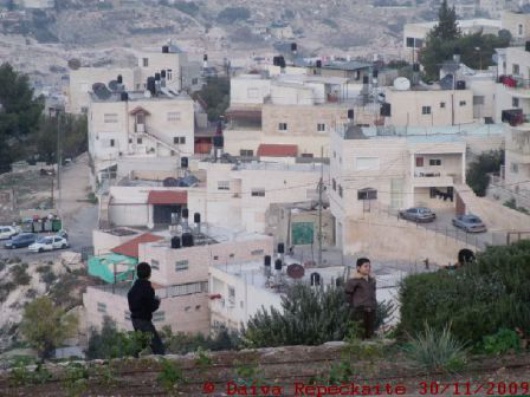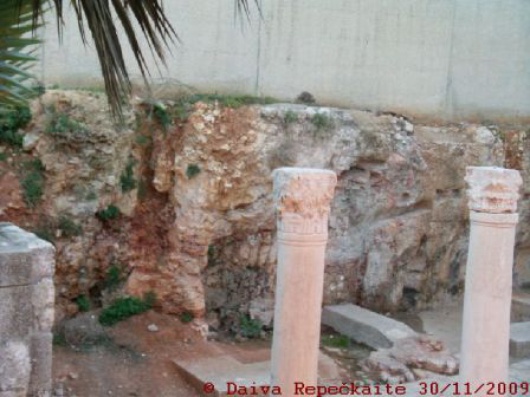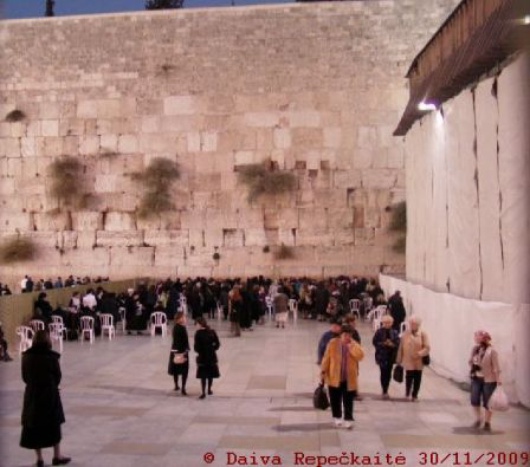Touristic Jerusalem
Published on
Thanks to Ulpan Gordon, I could see the most well-known places in Jerusalem with a fun tour guide. We visited Yad Vashem, had lunch at a mall near the big stadium (oh well...), went to the famous spot for panoramic views, visited the Old City with particular attention to the Jewish Quarter (of the four), and finished the visit with the Western Wall.
 Overall, Jerusalem is no doubt a gorgeous city. Even its block houses are beautiful, and that's the best thing to be said about a city. You can also feel the presence of Arabs and Orthodox Jews, unlike in Tel Aviv.
Overall, Jerusalem is no doubt a gorgeous city. Even its block houses are beautiful, and that's the best thing to be said about a city. You can also feel the presence of Arabs and Orthodox Jews, unlike in Tel Aviv.
 Our tour guide Moshe patiently herds a crowd of children (I don't know if this is the effect of the middle-school atmosphere at the Hebrew ulpan, but some people did behave like kids), telling them about the highlings of the city on the way. We first start with a visit to Yad Vashem. I've been to many Holocaust museums, but this is said to be THE museum. It's designed so that it leads you in zigzags from a triangle depicting the life in a shtetl, to a... I won't spoil it, but this has to do with the creation of the state of Israel. It sort of the same idea as the [very good] Budapest Holocaust Museum, as it leads you down the path of humiliation and dehumanisation of the Jews in the hands of the Nazis (except that the Budapest museum also has a personal touch to it). Several rooms are dedicated to different aspects of the process: the people who saved Jews (one Lithuanian family is presented, too!), the armed resistance, cultural life in the ghettos, etc. I was very excited to find bios of Lithuanain resistance fighters and drawings of Alexander Bogen, whom I interviewed recently.
Our tour guide Moshe patiently herds a crowd of children (I don't know if this is the effect of the middle-school atmosphere at the Hebrew ulpan, but some people did behave like kids), telling them about the highlings of the city on the way. We first start with a visit to Yad Vashem. I've been to many Holocaust museums, but this is said to be THE museum. It's designed so that it leads you in zigzags from a triangle depicting the life in a shtetl, to a... I won't spoil it, but this has to do with the creation of the state of Israel. It sort of the same idea as the [very good] Budapest Holocaust Museum, as it leads you down the path of humiliation and dehumanisation of the Jews in the hands of the Nazis (except that the Budapest museum also has a personal touch to it). Several rooms are dedicated to different aspects of the process: the people who saved Jews (one Lithuanian family is presented, too!), the armed resistance, cultural life in the ghettos, etc. I was very excited to find bios of Lithuanain resistance fighters and drawings of Alexander Bogen, whom I interviewed recently.
Seeing a Holocaust museum in Israel is special in a sense that it gives a more generalised picture and highlights the similarities of the most modern, the most sophisticated and the most overwhelming genocide. Of course, it doesn't forget the differences among the different countries. It bravely highlights the cowardice of the world community, if it's ever possible to use such a word, the hypocricy of the Allies in handling refugees, and the big question - Why didn't anyone stop it?
What created a crowd of tearful eyes was not the presentation of historical facts though, but the hall with hundreds of photos of people, surrounding a well. It's almost unbearable to face the looks from the photos, and the voice of the guide, saying: "Look, look at them, how beautiful they were..." Of course, later the guide tells us that what's really important now is to build the country, to make 'us' feel good in the country, and encourage new people here to create families, businesses, etc.
After Yad Vashem we move to a mall near the stadium to have lunch, and then go to a place with a good panoramic view. Only then our trip to the Old City begins.
 There's no need to tell stories about how Jerusalem was changing hands. In the initial plan, before Israel appeared on the world map, the plan was to give it an international status. This was also suggested in a recent peace plan. Having seen Jerusalem, I think that the world would gain from such a plan, yet for Israel it would be an important symbolic loss.
There's no need to tell stories about how Jerusalem was changing hands. In the initial plan, before Israel appeared on the world map, the plan was to give it an international status. This was also suggested in a recent peace plan. Having seen Jerusalem, I think that the world would gain from such a plan, yet for Israel it would be an important symbolic loss.
The Western Wall was as I imagined it to be, hordes of people trying to get to it and squeeze a note into every available crack in the wall, not noticing other people's unsuccessfully wedged notes under their feet. Several women literally sob near the wall, it's a bit scary. Otherwise, the calm and respectful atmosphere is saturated with good energy.
 I generally refrain from taking photos of people at religious places, but this one is from afar, so I didn't 'steal their souls', I believe.
I generally refrain from taking photos of people at religious places, but this one is from afar, so I didn't 'steal their souls', I believe.
I'll certainly go back to Jerusalem again. With a guided bus tour, it's impossible to get any idea of spaces and distances. Yet I've done all the compulsory visits, so the next time can be fully devoted to getting to know the city.



